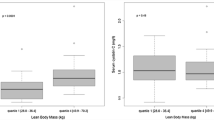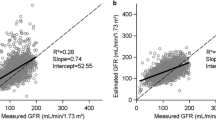Abstract
Purpose
Determining renal function is important for chemotherapy eligibility and dosing. Measured creatinine clearance (mCrCl) is the gold standard but is cumbersome. Equations estimating CrCl (eCrCl) based on serum creatinine (SCr) produce widely varying estimates. Considering that SCr is derived from skeletal muscle, this study prospectively developed a new eCrCl equation in cancer patients using CT-defined muscle surface area (MSA) and evaluated its utility in a separate, retrospective series.
Methods
In a prospective, observational cohort study of cancer patients, mCrCl by 24-h urine collection was correlated with CT-determined MSA to create an equation for eCrCl [muscle surface area (cm2) × 42/SCr]. eCrCl by Wright, Cockcroft–Gault (CG), CKD-EPI, MDRD, and MSA was compared to mCrCl to determine fit. MSA-eCrCl was used to simulate carboplatin dosing in a retrospective series of advanced non-small cell lung cancer (NSCLC).
Results
Prospectively, 22 patients were accrued and evaluable (12 males; median age 69). MSA-eCrCl correlated stronger (r 2 0.80) than current equations (r 2 0.47–0.69) with mCrCl. In calculating carboplatin doses for 89 NSCLC patients with MSA and CG-eCrCl, median error of CG-determined carboplatin dose was 5.5 % (range −19.0 to 44.2 %), assuming that MSA was better at estimating CrCl. Forty-two patients (47 %) received doses that varied ≥10 % of what was calculated by MSA.
Conclusions
We propose a new formula for eCrCl in patients that appears more accurate than current formulae and may have implications for chemotherapy efficacy and toxicity. Studies to validate this formula are under way.


Similar content being viewed by others
References
Stevens LA et al (2006) Assessing kidney function–measured and estimated glomerular filtration rate. N Engl J Med 354(23):2473–2483
Delanaye P et al (2011) Are the creatinine-based equations accurate to estimate glomerular filtration rate in African American populations? Clin J Am Soc Nephrol 6(4):906–912
Hudson JQ et al (2013) Performance of methods to assess kidney function in a predominantly overweight sample of patients with liver disease. Ren Fail 35(2):249–256
Finkel KW, Howard SC (2014) Onco-nephrology: an invitation to a new field. J Clin Oncol 32(22):2389–2390
Holweger K et al (2008) Novel algorithm for more accurate calculation of renal function in adults with cancer. Ann Pharmacother 42(12):1749–1757
Calvert AH et al (1989) Carboplatin dosage: prospective evaluation of a simple formula based on renal function. J Clin Oncol 7(11):1748–1756
Wright JD et al (2008) Carboplatin dosing in obese women with ovarian cancer: a Gynecologic Oncology Group study. Gynecol Oncol 109(3):353–358
Barrett SV et al (2008) Does body mass index affect progression-free or overall survival in patients with ovarian cancer? Results from SCOTROC I trial. Ann Oncol 19(5):898–902
Wright JG et al (2001) Estimation of glomerular filtration rate in cancer patients. Br J Cancer 84(4):452–459
Bouillanne O et al (2005) Geriatric Nutritional Risk Index: a new index for evaluating at-risk elderly medical patients. Am J Clin Nutr 82(4):777–783
Martin L et al (2013) Cancer cachexia in the age of obesity: skeletal muscle depletion is a powerful prognostic factor, independent of body mass index. J Clin Oncol 31(12):1539–1547
Shen W et al (2004) Total body skeletal muscle and adipose tissue volumes: estimation from a single abdominal cross-sectional image. J Appl Physiol 97(6):2333–2338
Mourtzakis M et al (2008) A practical and precise approach to quantification of body composition in cancer patients using computed tomography images acquired during routine care. Appl Physiol Nutr Metab 33(5):997–1006
Morgen CS, Sorensen TI (2014) Obesity: global trends in the prevalence of overweight and obesity. Nat Rev Endocrinol 10(9):513–514
US Food and Drug Administration (2000) Capecitabine (Xeloda)—highlights of prescribing information
Hunter RJ et al (2009) Dosing chemotherapy in obese patients: actual versus assigned body surface area (BSA). Cancer Treat Rev 35(1):69–78
Griggs JJ et al (2012) Appropriate chemotherapy dosing for obese adult patients with cancer: American Society of Clinical Oncology clinical practice guideline. J Clin Oncol 30(13):1553–1561
McIntosh JF, Moller E, Van Slyke DD (1928) Studies of urea excretion. III: The influence of body size on urea output. J Clin Invest 6(3):467–483
Wuerzner G et al (2010) Marked association between obesity and glomerular hyperfiltration: a cross-sectional study in an African population. Am J Kidney Dis 56(2):303–312
Kasiske BL, Napier J (1985) Glomerular sclerosis in patients with massive obesity. Am J Nephrol 5(1):45–50
Acknowledgments
Investigator-initiated grant funding was provided by the Alberta Cancer Foundation and Canadian Institutes of Health Research.
Conflict of interest
All authors declare no conflicts of interest.
Ethical standard
All procedures performed in the prospective component of this study involving human participants were in accordance with the ethical standards of the institutional research committee and with the 1964 Declaration of Helsinki and its later amendments or comparable ethical standards. The retrospective model did not require consent.
Author information
Authors and Affiliations
Corresponding author
Rights and permissions
About this article
Cite this article
Chu, M.P., McCaw, L., Stretch, C. et al. Development of a new equation to estimate creatinine clearance in cancer patients. Cancer Chemother Pharmacol 76, 117–124 (2015). https://doi.org/10.1007/s00280-015-2777-9
Received:
Accepted:
Published:
Issue Date:
DOI: https://doi.org/10.1007/s00280-015-2777-9




